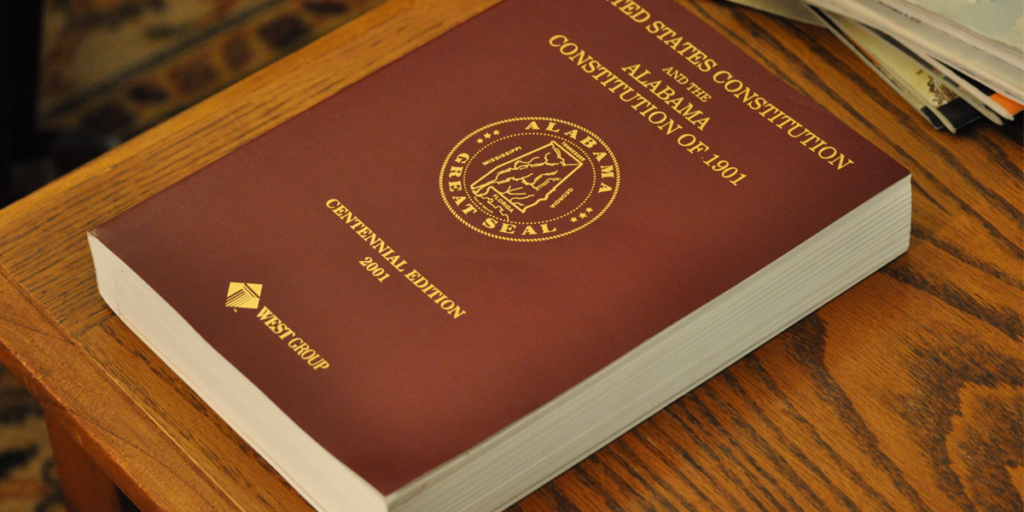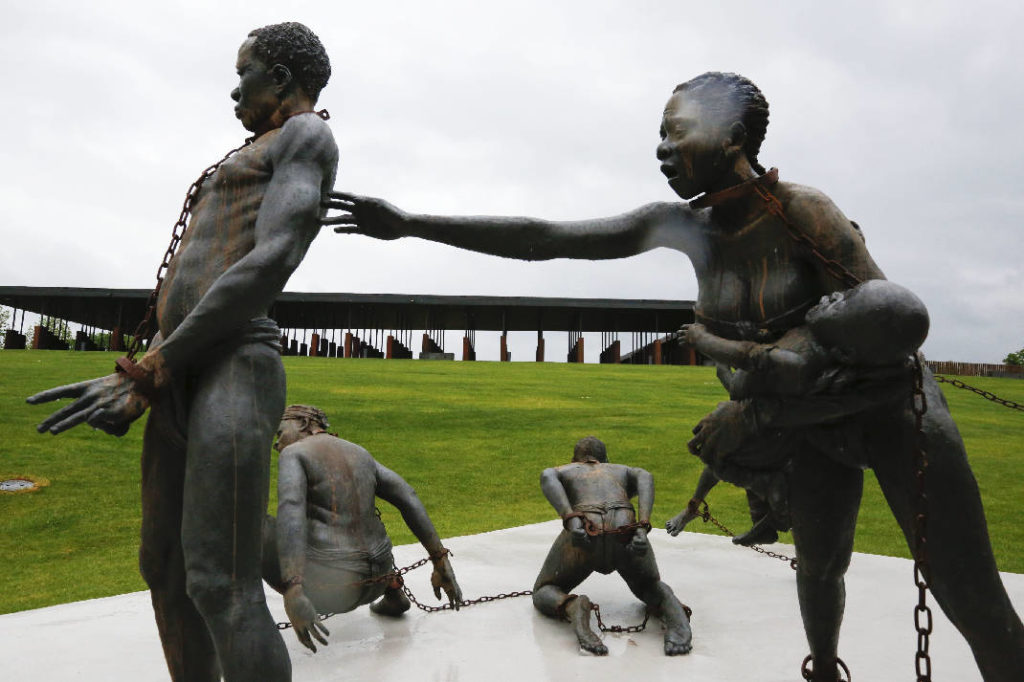Alabama seeks to purge racist language from Constitution

The Alabama Constitution, written in 1901, still has language stating that schools should be segregated by race and people are to pay poll taxes to vote. The Committee on the Recompilation of the Constitution on Wednesday approved a plan to strip racist language from the state’s governing document. It also reorganizes the massive, sprawling document that has nearly 1,000 constitutional amendments to try to make it more user-friendly. The committee’s proposal will be considered by lawmakers in the 2022 legislative session. If approved, it would go before voters in November of 2022. “The moving racist language portion, I think is a great first step in righting some of the wrongs of the past of the state of Alabama,” said Democratic Rep. Merika Coleman, who chairs the committee and sponsored the legislation setting up the process. “We know the spirit in which the document was written, and it was written specifically to disenfranchise, not only black Alabamians but also poor Alabamians.” The framers of the 1901 constitution were clear that their goal was to maintain a government controlled by white people. “The new constitution eliminates the ignorant negro vote and places the control of our government where God Almighty intended it should be -– with the Anglo-Saxon race,” John Knox, president of the constitutional convention, said in a speech urging voters to ratify the document. The pending plan would strip language on segregated schools and poll taxes and that allowed a brutal convict lease system that sold African American men, often arrested under dubious circumstances, into forced labor. While those provisions have largely been invalidated by court rulings, the vestiges of Jim Crow remain in the state’s chief governing document, such as the fight to maintain segregated schools. In the wake of the 1954 Supreme Court decision that said racially segregated schools were unconstitutional, Alabama adopted Constitutional Amendment 111 allowing parents to opt for students to “attend schools provided for their own race.” Proponents in Alabama are hopeful that this effort will succeed where others have failed. Voters in the mostly white, conservative state had rejected similar proposals twice since 2000 after they became intertwined with school funding issues. The committee is hoping to sidestep that issue by not altering language stating there is no right to a public education. State voters in 2000 did vote to remove a ban on interracial marriages but about 40% of voters cast ballots to keep the interracial marriage ban in the Constitution. Coleman said she is optimistic the proposal will win approval as long as no one tries to falsely tie the effort to the national politics or “some of the stuff that is going on nationally with critical race theory.” Coleman said striking the Jim Crow language sends a message that the state has changed. “It’s so heartbreaking when you hear negative connotations when it comes to Alabama when someone is talking about something that is backwards or outdated and they refer to it as ‘Bama.’ I think this is helpful in trying to let — not only the rest of the country know, but the world knows — that that is not who we are.” Republished with the permission of the Associated Press.
The Jim Crow film that just won’t die, “Song of the South”

Racially segregated movie theaters and whites-only water fountains disappeared decades ago after court rulings struck down the legal framework of Jim Crow America, but another element of the era just won’t die: Walt Disney’s 1946 movie “Song of the South.” With racist stereotypes and Old South tropes, the film isn’t available to the millions of subscribers of the company’s new Disney Plus streaming service, and it hasn’t been released in theaters in decades. Yet the movie, still beloved by many, lives on. “Song of the South” is easily viewed on the internet either in whole or in pieces, and numerous websites offer versions of the movie or memorabilia for sale. Animatronic characters and music from the movie are even featured in a ride at Disney World in Orlando, Florida, minus the racist context. The movie — a mix of live action, cartoons and music featuring an old black plantation laborer named Uncle Remus who enchants a white city boy with fables of talking animals — is like a zombie that keeps popping up seven decades after it was first released. While many find it racist and offensive, others see it as endearing. “Yay! Have been looking for a good copy for years, kids really enjoyed it! Thank you,” a reviewer wrote recently on the online marketplace Etsy, where multiple versions of the movie are for sale. Groups including the NAACP protested the film’s initial release, and arts professor Sheril Antonio said the continuing problem with “Song of the South” is that some just don’t see anything wrong with it. “Most of the harm of all of this is not acknowledging our shared history, all the good and bad of it. The harm comes from ignoring it and not talking about it truthfully and fully,” Antonio, a senior associate dean of arts at New York University, said in an interview conducted by email. Released the year after World War II ended, “Song of the South” premiered in Atlanta, where the Civil War epic “Gone With the Wind” made its debut a few years earlier. Set in post-Civil War Georgia, the Disney film featured stories that white newspaper writer Joel Chandler Harris heard from one-time slaves and published starting in 1876, according to The Wren’s Nest, Harris’ one-time home and now a museum in Atlanta. Actor James Baskett was presented an honorary Academy Award for his portrayal of Uncle Remus, but the movie was perhaps best known for its Oscar-winning song “Zip-A-Dee-Doo-Dah.” The tune is part of the soundtrack at Disney World’s Splash Mountain ride, which also features Remus characters including Br’er Rabbit. Yet while Disney Plus added a disclaimer to “Peter Pan,” “Dumbo”” and other vintage movies because they depict racist stereotypes, the company kept “Song of the South” locked away in its vault. Disney last screened the movie in 1986, its 40th anniversary, despite years of complaints that it showed blacks as subservient to whites, and it never released “Song of the South” for home video sales in the United States. Foreign versions of the movie are among the editions available for sale on the internet. “To be honest, I’ve lost track of how many people sell DVD bootlegs now,” said Christian Willis, who has run a website dedicated to the movie for about two decades. Jason Sperb, who wrote a book about the movie and its legacy, said “Song of the South” received a lukewarm reception when it first opened but was a “huge hit” financially when it was released in the 1970s and ’80s. “Disney had become more of a cultural institution by then. All the old films, whether successful or not upon its original release, were now being rebranded as ‘classics,”’ said Sperb, author of “Disney’s Most Notorious Film: Race, Convergence, and the Hidden Histories of Song of the South.” The continuing fascination that some have with the movie is likely more about the fact that Disney made it than its actual contents, he said in an email interview. “I think if anyone else in Hollywood had made that movie it would have been almost completely forgotten about by today except for only the most hardcore animation history buffs who would note in passing its role in helping to shape the possibilities of hybrid animation,” said Sperb. Willis, who runs the “Song of the South” website, said he was enamored with the movie after seeing it as a child in 1986 at age 6. He hopes the movie is released to the public again someday, and in the meantime he plans to keep adding to his online repository about the film. “I think burying history is the wrong approach,” he said. Some have reinterpreted old, racist films in a new way rather than simply screening them in their original format. Antonio, the NYU professor, cited DJ Spooky’s remix of the 1915 movie “Birth of a Nation,” which glorified the early Ku Klux Klan. In “Rebirth of a Nation,” DJ Spooky (whose birth name is Paul D. Miller) trimmed the original film and applied new graphics and music he composed. In a live performance during the 2016 presidential campaign, he spliced together the original film with scenes from the civil rights movement and post-9/11 wars. Antonio said she was “forever changed” by watching “Rebirth.” “As you can see I am an educator, and in these cultural artifacts there is always value,” she said. Republished with the Permission of the Associated Press.
Lynching memorial will show that women were victims too

A memorial to victims of lynching in the U.S. opens in Alabama on April 26, 2018. The National Memorial for Peace and Justice is a six-acre site that overlooks Montgomery, the state capital. It uses sculpture, art and design to give visitors a sense of the terror of lynching as they walk through a memorial square with 800 six-foot steel columns that symbolize the victims. The names of thousands of victims are engraved on columns – one for each county in the United States where a lynching took place. In Alabama alone, a reported total of 275 lynchings took place between 1871 and 1920. U.S. history books and documentaries that tell the story of lynching in the U.S. have focused on black male victims, to the exclusion of women. But women, too, were lynched – and many raped beforehand. In my book “Gender and Lynching,” I sought to tell the stories of these women and why they have been left out. Between 1880 and 1930, close to 200 women were murdered by lynch mobs in the American South, according to historian Crystal Feimster. Will this new memorial give these murdered women their due in how the U.S. remembers and feels about our troubling history? Enforcing white supremacy through terror In a recent report, Lynching in America, researchers documented 4,075 lynchings of African-Americans that were committed by southern whites in Alabama, Arkansas, Florida, Georgia, Kentucky, Louisiana, Mississippi, North Carolina, South Carolina, Tennessee, Texas and Virginia between 1877 and 1950. Lynching differed from ordinary murder or assault. It was celebrated by members of the Ku Klux Klan as a spectacular event and drew large crowds of people who tortured victims, burned them alive and dismembered them. Lynching was a form of domestic terrorism that inflicted harm onto individuals and upon an entire race of people, with the purpose of instilling fear. It served to give dramatic warning that the ironclad system of white supremacy was not to be challenged by word, deed or even thought. The conventional approach to teaching the history of Jim Crow and lynching has focused almost exclusively on the black male victim. However, such an approach often simplifies and distorts a much more complex history. Not all victims were African-American men, and although allegations of African-American men raping white women were common, such allegations were not the leading motive for the lynchings. We know from the pioneering work of anti-lynching crusader Ida B. Wells-Barnett that African-American men, women and children were lynched for a range of alleged crimes and social infractions. The book “Trouble in Mind,” by Pulitzer Prize-winning historian Leon Litwack, provides a detailed account of the many accusations of petty theft, labor disputes, arson and murder that led to these lynchings. This fact requires a richer, more nuanced understanding of discrimination that is critical of racism and sexism at the same time. Martyrs such as Laura Nelson and Mary Turner experienced racial and sexual violence at the hands of vigilante lynch mobs because of their race and gender. Laura Nelson and Mary Turner In May 1911, Laura Nelson was lynched in Okemah, Oklahoma. Nelson allegedly shot a sheriff to protect her son. The officer had been searching her cabin for stolen goods as part of a meat-pilfering investigation. A mob seized Nelson along with her son, who was only 14 years old, and lynched them both. However, Nelson was first raped by several men. The bodies of Laura and her son were hung from a bridge for hundreds of people to see. The title of Mayhorn’s installation, “A Woman Was Lynched the Other Day,” refers to a banner the New York NAACP would unfurl from their Fifth Avenue office when news of another lynching surfaced. With white letters inscribed on a black background, it declared “A MAN WAS LYNCHED YESTERDAY” and became a rallying cry for justice. The violent murder of African-Americans was so accepted at the time that a postcard was made of Nelson’s lynching by George Henry Farnum, a photographer. Brooklyn-based artist Kim Mayhorn created in 1998 a multimedia installation that memorialized Nelson’s death. There’s an empty dress in Mayhorn’s installation that resembles the postcard of her lynching. The disembodied dress represents the void in the historical record and Mayhorn’s effort to redress the absence of Nelson. Seven years later, in May 1918, Mary Turner was eight months pregnant when a mob of several hundred men and women murdered her in Valdosta, Georgia. The Associated Press reported that she had made “unwise remarks” and “flew into a rage” about the lynching of her husband, insisting that she would press charges against the men responsible. Her death has since been recognized by local residents, students and faculty at Valdosta State University, first with a public ceremony that placed a cross at the lynching site and second with a historical marker in 2010. Nelson and Turner have often been depicted as tragic characters or “collateral victims” who supported and defended the males in their lives. Such deaths, however, were not incidental. They were essential to maintain white supremacy, as a form of punishment for defying the social order. Though women represent a minority of lynching victims, their stories challenge previous attempts to justify lynching as necessary to protect white women from black male rapists. Understanding lynching and the motives behind it requires including the stories of African-American women who were robbed of dignity, respect and bodily integrity by a weapon of terror. The violence against them was used to maintain a caste system that assigned inferior roles to African-American women and men alike. Redefining the ‘civil rights movement’ By including women in the historical narrative of lynching, the new memorial in Alabama reveals a more complete understanding of this devastating social practice. This memorial brings African-American women like Nelson and Turner to the fore as victims, and the weight of visual evidence on display at the memorial challenges the silence surrounding their deaths. The Equal Justice Initiative assists scholars, teachers and ordinary people in recognizing the roots of the civil rights movement that began long before the years 1954-68. The monument sheds light in an
Robert Bentley says UDSOT investigation a “weak attempt to embarrass” Alabama

Gov. Robert Bentley came out with a strongly worded statement against the federal Department of Transportation’s ongoing investigation into the state of Alabama’s recent changes to its driver’s license regime in the wake of budget cuts in Montgomery. The second-term Republican said certain Democrats and Obama administration officials are trying to make political hay of what is essentially a simple state governmental change to increase efficiency. “In an ongoing attempt to politicize a resolved issue, the United States Department of Justice informed my office Tuesday of an impending investigation by the United States Department of Transportation (USDOT) that is in its early stages and no findings have been made,” said Bentley. “Due to legislative budget cuts, in September 2015, the Alabama Law Enforcement Agency (ALEA) reallocated driver license examination personnel back to the district drivers license offices on a full time basis. Prior to this budget decision, these examiners, who are state employees, were traveling to each county level probate office or courthouse once or twice a week to provide the service of examination. I made the decision in October 2015 to ensure that an examiner report to each county level office at least once a month to continue providing this service,” the governor explained. Democratic presidential front-runner Hillary Rodham Clinton lambasted the Bentley administration over the move during a campaign stop in Alabama in October, calling the reallocation of resources “a blast from the Jim Crow past,” referring to segregation-era policies in the state and elsewhere in the South designed to depress African-American voter turnout. Bentley went on to say the ongoing investigation into possible Civl Rights violations is baseless, and a waste of time and money by bureaucrats in Washington. “Despite what the Obama Administration claims, there were no driver license offices closed in Alabama,” said Bentley. “Despite facts to the contrary, opportunistic politicians such as Hillary Clinton have politicized an Alabama budgeting issue to serve their own agenda, going so far as to travel to our state for the sole purpose of political pandering. “This USDOT investigation is nothing more than a weak attempt to embarrass the people of Alabama and exploit our state in the name of a political agenda. I am confident that the USDOT investigation will find no basis for the claims of discrimination. It is time for the Obama Administration and aspiring national politicians to listen to facts, stop wasting taxpayers’ dollars and put the political agendas away,” Bentley concluded.
Hillary Clinton to speak at Montgomery bus boycott anniversary event

Democratic presidential candidate Hillary Clinton is traveling to Alabama to mark the 60th anniversary of the Montgomery Bus Boycott. Clinton will speak Tuesday morning at the Montgomery, Alabama, church pastored by the Rev. Martin Luther King Jr. during the boycott. Her speech falls on the anniversary of Rosa Parks‘ Dec. 1, 1955 arrest for refusing to give her bus seat to a white passenger. Her arrest sparked the 381-day boycott of Montgomery buses by blacks to protest segregated seating. In stops in the South, the Democratic presidential front-runner has been working to solidify her advantage among African-American voters. Black voters make up a major portion of the Democratic primary electorate in Southern states holding early primaries in 2016. Republished with permission of The Associated Press.
Hillary Clinton names Terri Sewell, legislative Dems to state campaign committee

Democratic presidential candidate Hillary Rodham Clinton named a slew of progressive Alabamians to her state campaign committee on Friday, which she is calling the “Alabama Leadership Council.” Among the most powerful members of the 60-member council of supporters is U.S. Rep. Terri Sewell, a Democratic congresswoman and the first black woman to represent Alabama in Congress. A number of state lawmakers in Montgomery also made the list, including Sen. Vivian Davis Figure, Rep. Napolean Bracy, and Rep. James Buskey. Longtime supporter and former state co-chair Pat Edington also made the list, as did Vivian Beckerle and Timothy Bolden. The list of Hillary-supporting Yellowhammer State Democrats also includes several party insiders who also cast a vote in the party’s nominating convention. Observers say her path to victory includes running an extensive behind-the-scenes campaign for her party’s delegates, of whom reports say she has racked already secured half. Clinton made a handful of campaign stops in Alabama last week, ahead of her designation of campaign committee members. She weighed in on the closure of several state driver’s license offices – an issue championed by Sewell – last month as well, calling the move “a blast from the Jim Crow past.” Democrats’ chances of winning carrying Alabama’s are slim to none. The last time the state voted for a Democratic president was in 1976, when then-Georgia Gov. Jimmy Carter captured the state’s support.


